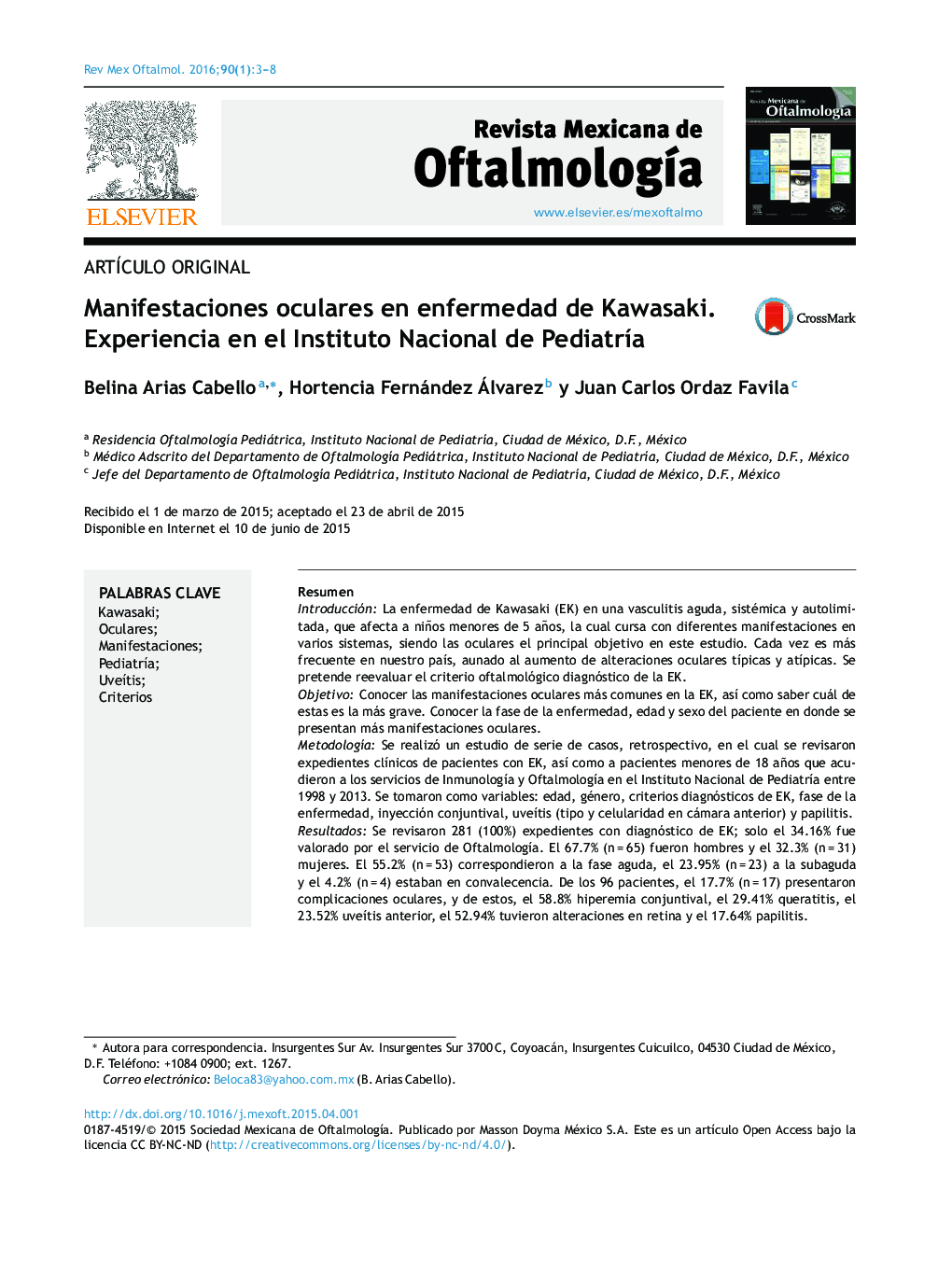| Article ID | Journal | Published Year | Pages | File Type |
|---|---|---|---|---|
| 4032251 | Revista Mexicana de Oftalmología | 2016 | 6 Pages |
ResumenIntroducciónLa enfermedad de Kawasaki (EK) en una vasculitis aguda, sistémica y autolimitada, que afecta a niños menores de 5 años, la cual cursa con diferentes manifestaciones en varios sistemas, siendo las oculares el principal objetivo en este estudio. Cada vez es más frecuente en nuestro país, aunado al aumento de alteraciones oculares típicas y atípicas. Se pretende reevaluar el criterio oftalmológico diagnóstico de la EK.ObjetivoConocer las manifestaciones oculares más comunes en la EK, así como saber cuál de estas es la más grave. Conocer la fase de la enfermedad, edad y sexo del paciente en donde se presentan más manifestaciones oculares.MetodologíaSe realizó un estudio de serie de casos, retrospectivo, en el cual se revisaron expedientes clínicos de pacientes con EK, así como a pacientes menores de 18 años que acudieron a los servicios de Inmunología y Oftalmología en el Instituto Nacional de Pediatría entre 1998 y 2013. Se tomaron como variables: edad, género, criterios diagnósticos de EK, fase de la enfermedad, inyección conjuntival, uveítis (tipo y celularidad en cámara anterior) y papilitis.ResultadosSe revisaron 281 (100%) expedientes con diagnóstico de EK; solo el 34.16% fue valorado por el servicio de Oftalmología. El 67.7% (n = 65) fueron hombres y el 32.3% (n = 31) mujeres. El 55.2% (n = 53) correspondieron a la fase aguda, el 23.95% (n = 23) a la subaguda y el 4.2% (n = 4) estaban en convalecencia. De los 96 pacientes, el 17.7% (n = 17) presentaron complicaciones oculares, y de estos, el 58.8% hiperemia conjuntival, el 29.41% queratitis, el 23.52% uveítis anterior, el 52.94% tuvieron alteraciones en retina y el 17.64% papilitis.ConclusionesLa manifestación ocular de la EK más común fue la hiperemia o inyección conjuntival, seguida de uveítis anterior aguda bilateral. En la fase aguda es donde se presentan la mayoría de las manifestaciones oftalmológicas, los hombres fueron los más afectados y los menores de 5 años.
IntroductionKawasaki's disease (KD) is an acute vasculitis, systemic and self-limited, that affects children under 5 years; it has different systemic features, being the ophthalmologic ones the aim of this study. It is getting more often in Mexico, as well as a rise on atipic and tipic ocular features. We intend to reassess the diagnostic criterion for this disease.ObjectiveDescribe the most often ocular features in KD, as well as the most severe one. Describe in which phase, age and gender the ocular features are more often.MethologyA retrospective and case series study was run, doing a review of clinical records as well as patients under 18 years that attended the Inmunology and Ophthalmology departments at the Pediatric National Institute from 1998 to 2013. Data collected were: age, gender, KD diagnostic criteria, phase of disease, conjunctival hyperemia, uveitis (localization and cellularity) and papilitis.Results281 (100%) clinical records with KD, only 34.16% (n = 96) had an ophthalmologic checkup. 67.7% were males, 32.3% female. 55.2% were in the acute phase, 23.95% subacute and 4.2% on the convalescence one. From this 96, 17.7% had ocular complications, 58.8% conjunctival hyperemia, 29.41% keratitis, 23.52% anterior uveitis, 52.94% retina involvement and 17.64% papilitis.Conclusionsthe most common ophthalmologic feature of KD was the conjunctival hyperemia, followed by an acute bilateral anterior uveitis. During the acute phase, is more often that we can find ocular features, which also are more common in males and on patients under 5 years
